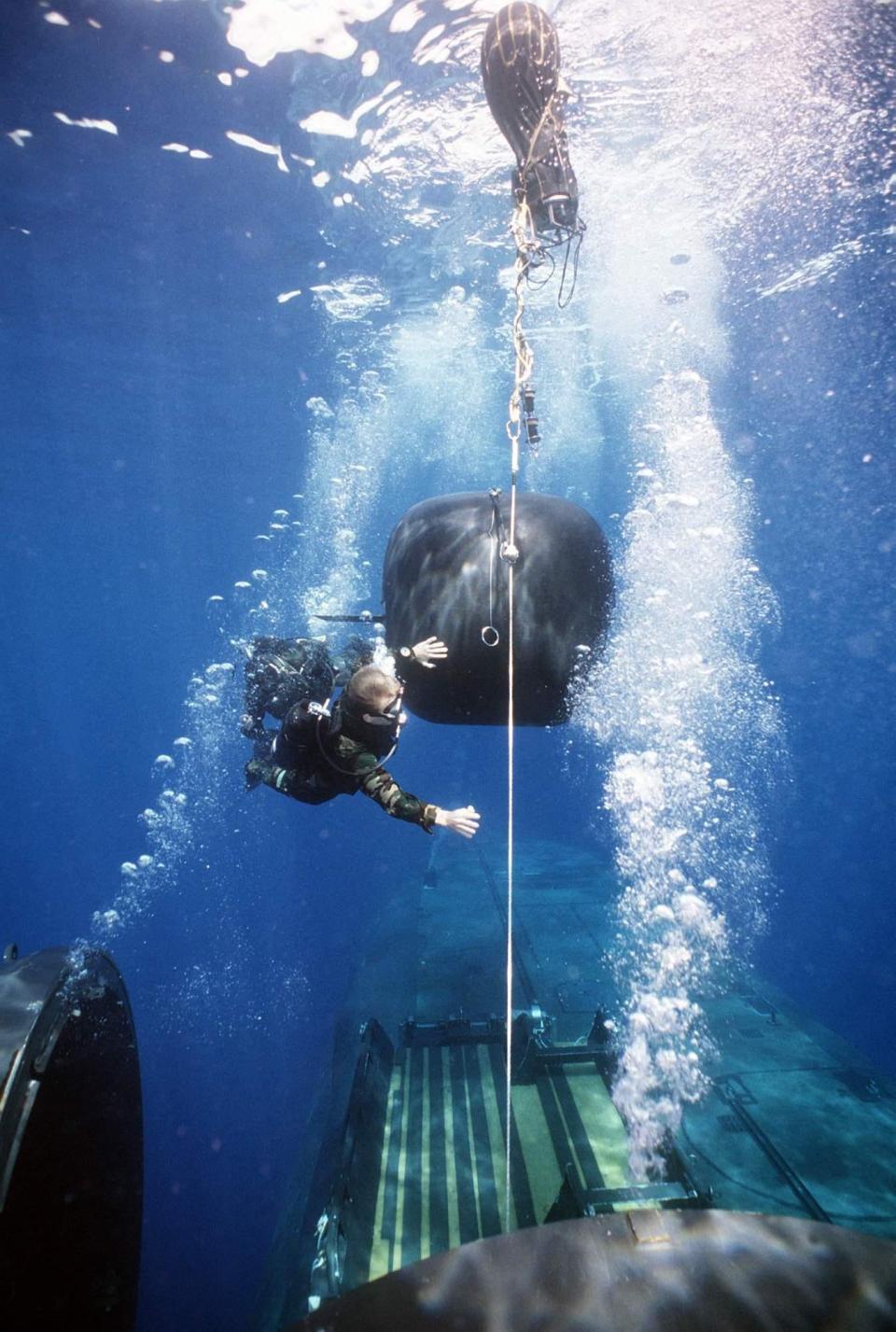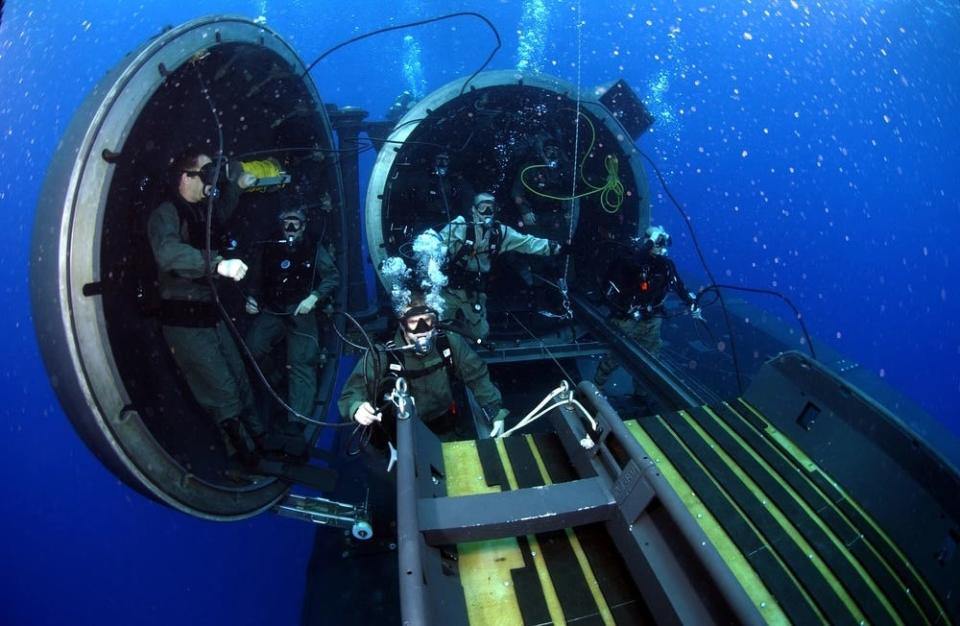Photos show US Navy SEAL operations aboard hidden shelters on submarines

Dry deck shelters have transformed missions aboard US military submarines.
A DDS is a large chamber that launches SEALs from underwater for missions.
Photos show the underwater special operations facilitated by the dry deck shelters.
Dry deck shelters aboard US military submarines play a vital role in naval operations, turning these lurking ship-hunters into motherships for Navy SEAL raids.
Photos show the special operations that are facilitated by a dry deck shelter, such as covertly launching Navy SEALs in submersible vehicles more efficiently.
What is a dry deck shelter?

A dry deck shelter, or DDS for short, is a long cylindrical lockout module near the sail on the deck of US Navy submarines.
Before the DDS, a small air-tight compartment named a lockout trunk could hold only one diving pair and a trunk operator at a time. The process of pressurizing the chamber for just two divers took as long as 10 minutes, which severely hindered efficiency if an entire squadron needed to be deployed and left the sub vulnerable to attack.
In the 1960s, the USS Grayback, a formerly decommissioned diesel-electric submarine, was brought back into action to remedy the inefficiency.
After the Grayback was decommissioned in 1964, the sub was repurposed four years later, converting its empty hangar bays into dry and wet compartments to store equipment and launch divers and SEAL delivery vehicles, respectively.
The Grayback's converted missile bays streamlined special operations, facilitating the deployment of platoons quickly and covertly. The design was later adapted into what would become DDSs.
Ample room for equipment and personnel

A DDS is about 9 feet high and wide and 38 feet long and can displace about 30 tons on top of the submarine's displacement.
It's large enough to house a whole crew of Navy SEALs, divers, an inflatable boat named a Combat Rubber Raiding Craft, or even a submersible vehicle known as a SEAL delivery vehicle.
A SEAL delivery vehicle in action

A SEAL delivery vehicle, or SDV, provides the underwater propulsion to carry a small team and their weapons and gear for long distances to reduce the chances of being spotted if they were in a small boat.
An SDV is a small, free-flooding submersible that can carry up to six SEALs for transport. The combat-equipped SEALs breathe through compressed air via an underwater breathing apparatus or through an internal life-support system aboard the SDV.
An excerpt from a 1952 then-classified report on "underwater swimmers" highlighted the importance SDVs played in special operations aboard submarines, noting that "whenever it is necessary to operate near an enemy-held shore in as complete secrecy as possible, the approach to the objective must be made underwater."
"The first part of the approach can be made in a fleet-type submarine, but these 1500-ton vessels cannot operate submerged in water shallower than 60 feet, and depths less than 150 feet are considered hazardous," the report said. "The final submerged approach must be made by swimming or in a small submersible."
Three-chamber design

The DDS comprises of three compartments: a hyperbaric operations bay, a transfer trunk, and a lockout chamber.
The forward-most hyperbaric chamber in the DDS is used to treat injured combat divers.
In the middle, the transfer trunk serves as an entry and exit point for equipment and personnel to the other chambers of the DDS and the rest of the sub.
At the rear, the lockout chamber operates similarly to the Grayback's converted hangar, used to quickly stage and deploy divers, SDVs, and Combat Rubber Raiding Crafts.
A look inside a flooded DDS

All three chambers of the DDS are made of HY-80 military-grade steel with fiberglass-reinforced plastics, allowing each chamber to withstand water pressures of at least 130 feet. The dry deck is flooded for the entry and exit of divers.
Its expected service life is at least 40 years.
Which submarines have a DDS?

Several submarines have been specially fitted with a DDS. In 1982, the USS Cavalla, a Sturgeon-class attack submarine, was the first submarine to receive a DDS. Other vessels in its class had a DDS, including the USS Silversides, William H. Bates, Tunny, and L. Mendel Rivers.
Two ballistic-missile submarines in the Ethan Allen-class — the USS Sam Houston and John Marshall — had a DDS, as well as the USS Kamehameha and James K. Polk of the Benjamin Franklin-class.
The USS Los Angeles (the flagship of Los Angeles-class subs), Philadelphia, Dallas, La Jolla, and Buffalo were capable of carrying the DDS. It's also aboard the USS Jimmy Carter, a Seawolf-class attack submarine, and several hulls in the Virginia-class.
Four ballistic-missile submarines were reclassified as guided-missile subs and modified to fit a DDS: the Ohio-class USS Ohio, Michigan, Georgia, and Florida.
Dual DDS carriers

While having one DDS aboard a submarine has proven to be advantageous, having two is even better.
Before the early 2000s, most DDS-fitted submarines had only one, but four were dual carriers: the USS Sam Houston, John Marshall, James K. Polk, and Kamehameha.
Special operations aboard the USS Kamehameha

Finding the next generation of dual-shelter submarines

The Kamehameha was the last of the dual-carrier subs to be decommissioned in 2002, prompting the Navy to figure out which vessels would fill its place.
Instead of creating a group of new dual-DDS platforms, the Navy turned to an existing fleet: Ohio-class nuclear-powered ballistic-missile submarines, or SSBNs.
Transforming a fleet

In 1994, a nuclear posture review found that the Navy needed only 14 of its 18 SSBNs, allowing it to repurpose the first four Ohio-class SSBNs to guided-missile submarines, or SSGNs, that fire long-range Tomahawk strike missiles.
A new SSGN layout

The Ohio, the flagship of the class, entered the shipyard in November 2003 to convert its capabilities into an SSGN, which includes hosting a DDS.
The Ohio's Trident-missile tubes were turned into lockout chambers and equipment storage, allowing it to hold submersibles, divers, unmanned vehicles, or Tomahawk land-attack missiles.
The Ohio completed its conversion into an SSGN in December 2005, deploying for the first time in October 2007.
The USS Florida was also originally an Ohio-class ballistic submarine before being converted in 2006. The 560-foot submarine is armed with four torpedo tubes and up to 154 Tomahawk land-attack missiles — the most of any US warship.
Most recently, the Florida was among the firepower used by US forces to strike against Houthi military targets in Yemen last month. More than 80 Tomahawks were used as part of the strike against Houthi rebels, though it wasn't immediately clear how many came from the USS Florida.
The strikes came after repeated warnings of retaliation to the Iranian-backed rebels' attacks on commercial ships in the Red Sea.
Alongside the Florida and Ohio, the USS Michigan and USS Georgia were also turned into guided-missile boats.
Recycling the reclassified SSGNs

The glory days for the SSGN converts are coming to an end.
In 2021, the Navy released a 30-year plan to build more than 400 new vessels by 2051 and, in the process, retire 304 current vessels, including the Ohio-class SSGNs.
The reclassified submarines are expected to be decommissioned between 2027 and 2040, with a possibility of extension amid potential delays of its successor, Virginia-class Block V nuclear-powered attack subs.
The Navy is looking to modernize its fleet of submarines by incorporating more manned- and unmanned-underwater-vehicle operations.
While larger UUVs can be launched from land and controlled on long-duration missions, some medium-sized UUVs can only deploy and be recovered on a dry deck shelter, meaning the hull attachment could persist in the Navy's fleet for a little longer.
Read the original article on Business Insider


